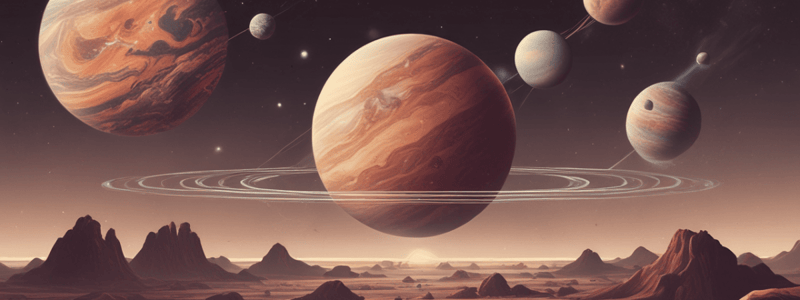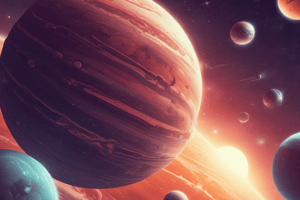Podcast
Questions and Answers
Which of the following planets is classified as an icy giant?
Which of the following planets is classified as an icy giant?
- Neptune (correct)
- Saturn
- Jupiter
- Mars
What term is used to describe the outer planets collectively?
What term is used to describe the outer planets collectively?
- Celestial planets
- Jovian planets (correct)
- Lunar planets
- Terrestrial planets
Which planet is known as the largest in the solar system?
Which planet is known as the largest in the solar system?
- Neptune
- Uranus
- Jupiter (correct)
- Saturn
What distance from the Sun is Jupiter approximately located?
What distance from the Sun is Jupiter approximately located?
Which of the following is NOT classified as an outer planet?
Which of the following is NOT classified as an outer planet?
Which characteristic is shared by the outer planets?
Which characteristic is shared by the outer planets?
What is the main characteristic shared by Jupiter and Neptune?
What is the main characteristic shared by Jupiter and Neptune?
Which of the following correctly identifies the inner planets?
Which of the following correctly identifies the inner planets?
What separates the inner planets from the outer planets?
What separates the inner planets from the outer planets?
How do the sizes of the inner planets compare to the outer planets?
How do the sizes of the inner planets compare to the outer planets?
What are the primary materials composing the outer planets?
What are the primary materials composing the outer planets?
Which planet is known for its Great Red Spot?
Which planet is known for its Great Red Spot?
Which of the following statements is true regarding the formation of inner and outer planets?
Which of the following statements is true regarding the formation of inner and outer planets?
Which of the following pairs of planets each have their own specific storm feature?
Which of the following pairs of planets each have their own specific storm feature?
What is the primary composition of the atmospheres of gas giants like Jupiter and Saturn?
What is the primary composition of the atmospheres of gas giants like Jupiter and Saturn?
Which planet has the largest number of confirmed moons as of the current writing?
Which planet has the largest number of confirmed moons as of the current writing?
Which distinguishing characteristic is unique to Uranus compared to the other outer planets?
Which distinguishing characteristic is unique to Uranus compared to the other outer planets?
What are the outer planets collectively known for in comparison to the inner planets?
What are the outer planets collectively known for in comparison to the inner planets?
Which of the following planets is classified as an icy giant?
Which of the following planets is classified as an icy giant?
How many rings does Neptune have, as currently known?
How many rings does Neptune have, as currently known?
What is the main distinguishing feature of Saturn compared to other outer planets?
What is the main distinguishing feature of Saturn compared to other outer planets?
Which statement accurately describes the composition of Uranus?
Which statement accurately describes the composition of Uranus?
How does the number of moons differ among the outer planets?
How does the number of moons differ among the outer planets?
What unique rotational characteristic does Uranus possess?
What unique rotational characteristic does Uranus possess?
Which characteristic is true for all the outer planets?
Which characteristic is true for all the outer planets?
Which of the following offers the best description of the formation of outer planets?
Which of the following offers the best description of the formation of outer planets?
Which of the following characterizes the outer planets compared to the inner planets?
Which of the following characterizes the outer planets compared to the inner planets?
What term is often used to describe Jupiter and Saturn among the outer planets?
What term is often used to describe Jupiter and Saturn among the outer planets?
What distance does Jupiter approximate from the Sun?
What distance does Jupiter approximate from the Sun?
Which planets are categorized as icy giants?
Which planets are categorized as icy giants?
What characteristic differentiates the term Jovian from other planetary classifications?
What characteristic differentiates the term Jovian from other planetary classifications?
Which of the following statements about Pluto is correct?
Which of the following statements about Pluto is correct?
Which of the following statements correctly describes a feature of both Jupiter and Neptune?
Which of the following statements correctly describes a feature of both Jupiter and Neptune?
What is the main component that differentiates the inner planets from the outer planets?
What is the main component that differentiates the inner planets from the outer planets?
Which planets are classified as the inner planets?
Which planets are classified as the inner planets?
What is located between the inner planets and the outer planets?
What is located between the inner planets and the outer planets?
Which characteristic is unique to Jupiter and Neptune when compared to other planets?
Which characteristic is unique to Jupiter and Neptune when compared to other planets?
Which aspect of Jupiter and Neptune's formation is similar?
Which aspect of Jupiter and Neptune's formation is similar?
Why are the inner planets generally smaller than the outer planets?
Why are the inner planets generally smaller than the outer planets?
Which statement applies solely to Jupiter and Neptune and not to any other planets?
Which statement applies solely to Jupiter and Neptune and not to any other planets?
Flashcards are hidden until you start studying
Study Notes
Outer Planets Overview
- The outer planets are the four planets farthest from the Sun in our solar system: Jupiter, Saturn, Uranus, and Neptune.
- They are also known as the Jovian planets, named after Jupiter.
- These planets share similarities in formation, environment, size, and satellites that distinguish them from the inner planets.
The Outer Planets
- Jupiter
- Largest planet in the solar system
- Diameter: approximately 11 times that of Earth
- Distance from the Sun: approximately 484 million miles
- Atmosphere: mostly hydrogen and helium gas
- Notable features: Great Red Spot, at least 95 moons
- Saturn
- Second-largest planet in the solar system
- Diameter: approximately 9 times that of Earth
- Distance from the Sun: approximately 886 million miles
- Atmosphere: mostly hydrogen and helium gas
- Notable features: prominent ring system, at least 146 moons
- Uranus
- Seventh planet from the Sun
- Diameter: approximately 15,759 miles
- Distance from the Sun: approximately 1.8 billion miles
- Atmosphere: mostly hydrogen, helium, and methane
- Notable features: 13 known rings, 27 known moons, unique rotation axis
- Neptune
- Eighth planet from the Sun
- Diameter: approximately 15,299 miles
- Distance from the Sun: approximately 2.8 billion miles
- Atmosphere: mostly hydrogen, helium, and methane
- Notable features: icy giant, 6 main rings, at least 16 moons
Outer Planet Properties
- Composition: Jupiter and Saturn are gas giants, composed mostly of hydrogen and helium, while Uranus and Neptune are icy giants, composed mostly of water, methane, and ammonia.
- Moons: The outer planets have many satellites, with Jupiter having 95, Saturn having 146, Uranus having 27, and Neptune having 16.
- Rings: All four outer planets have ring systems, with Saturn having the largest and most visible system.
- Formation: The outer planets are thought to have formed from the leftover gas, dust, and icy particles that surrounded the Sun after the formation of the inner planets.
Comparison with Inner Planets
- Boundary: The boundary between the inner and outer planets lies between Mars and Jupiter, known as the asteroid belt.
- Main differences: Inner planets are smaller, composed of solid materials, and closer to the Sun, while outer planets are larger, composed of gas, liquid, and icy materials, and farther from the Sun.
Additional Facts
- Jupiter and Neptune share the characteristic of having large storms on their surfaces, known as the Great Red Spot and the Great Dark Spot, respectively.
Overview of Outer Planets
- The solar system consists of eight planets: Mercury, Venus, Earth, Mars (inner planets) and Jupiter, Saturn, Uranus, Neptune (outer planets).
- Outer planets are also known as Jovian planets or gas giants (Jupiter, Saturn) and icy giants (Uranus, Neptune).
Characteristics of Outer Planets
- All share common features: gas composition, rings, and numerous moons.
- Formation involved leftover gas, dust, and icy particles from the solar system's creation.
Jupiter
- Largest planet in the solar system; eleven Earths can fit across its equator.
- Approximately 484 million miles from the Sun; radius is around 43,441 miles.
- Atmosphere primarily consists of hydrogen and helium; classified as a gas giant.
- Notable features include at least 95 moons and the Great Red Spot, a storm larger than Earth.
- Has faint rings.
Saturn
- Second largest planet; nine Earths can fit across its diameter (excluding rings).
- Located about 886 million miles from the Sun; radius measures 36,184 miles.
- Atmosphere similar to Jupiter, composed predominantly of hydrogen and helium.
- Distinguished by a prominent ring system (seven main rings) and at least 146 moons.
Uranus
- Seventh planet from the Sun, approximately 1.8 billion miles away; diameter of about 15,759 miles.
- Atmosphere contains hydrogen, helium, and methane; known as an icy giant due to large icy content.
- Features 13 known rings and 27 moons; unique axial tilt leads to horizontal rotation.
Neptune
- Outermost planet, 2.8 billion miles from the Sun; radius around 15,299 miles.
- Atmosphere primarily made of hydrogen, helium, and methane, also classified as an icy giant.
- Known as the "blue planet"; has at least 16 moons and 6 main rings.
Properties of Outer Planets
- Gas Giants vs. Icy Giants: Jupiter and Saturn are gas giants primarily made of hydrogen and helium, while Uranus and Neptune are icy giants composed of water, methane, and ammonia.
- Moons: Outer planets host significantly more moons compared to inner planets (Jupiter: 95, Saturn: 146, Uranus: 27, Neptune: 16).
- Rings: All outer planets have ring systems; Saturn has the largest and most visible rings.
Formation and Comparison to Inner Planets
- Outer planets formed from leftover materials after the formation of the inner planets.
- Key differences from inner planets: size (outer planets are larger), composition (outer planets are mostly gas or ice, while inner planets are rocky), and proximity to the Sun (outer planets are farther away).
Distinguishing Features
- Jupiter and Neptune are unique for their storm features: Jupiter's Great Red Spot and Neptune's Great Dark Spot.
- The boundary between inner and outer planets is defined by the asteroid belt, located between Mars and Jupiter.
Studying That Suits You
Use AI to generate personalized quizzes and flashcards to suit your learning preferences.




